Project Overview
 In July 2019, the City hired consultant team Angelo Planning Group and Johnson Economics to conduct a buildable lands inventory and prepare a Housing Needs Analysis and Economic Opportunities Analysis so the city can better understand its capacity for residential and employment growth within City limits and the Urban Growth Boundary (UGB) to 2040.
In July 2019, the City hired consultant team Angelo Planning Group and Johnson Economics to conduct a buildable lands inventory and prepare a Housing Needs Analysis and Economic Opportunities Analysis so the city can better understand its capacity for residential and employment growth within City limits and the Urban Growth Boundary (UGB) to 2040.
The Housing Needs Analysis will satisfy Statewide Planning Goal 10, which requires cities to assess current and 20-year housing needs by tenure, cost, and unit type, and ensure policies and codes address needs. The analysis provides essential data and recommends strategies for the city to consider in order to address housing needs to 2040. The analysis and strategies are a critical first step to preparing a Housing Production Strategy, which is a new requirement of House Bill 2003. Learn more on the Housing Needs Analysis tab above.
The Economic Opportunities Analysis projects employment to 2040 and determines the type and sizes of land that are projected to be needed to accommodate employment growth. The analysis provides a foundation for the City to develop an economic development strategy. Learn more on the Economic Opportunities Analysis tab above.
Housing Needs Analysis
Housing Needs Analysis
The Portland State University official forecasted annual growth rate of 1.27% per year was used to project growth to 2040. Since Albany has grown faster than the PSU baseline forecast, an alternative forecast was prepared that reflects Albany’s average annual growth rate of 1.69% since 1992.
Depending on the rate of growth, the City is projected to add between 16,800 and 23,300 new residents to 2040, requiring between 6,750 and 9,400 new housing units after factoring for group quarters.
The following conclusions regarding housing and residential land needs in Albany were identified:
- When factoring for the most constrained scenarios and more aggressive growth rate, there is inadequate capacity within the City limits to 2040, but there is still adequate available land within the UGB for 20 years.
- If historic trends in housing types and tenancy continue, there will likely be demand for land that can accommodate medium density housing (8 to 18 units/acre), and for higher density housing (more than 18 units an acre).
- There is a current and projected need for more affordable housing opportunities for many Albany households. Over 50% of renters spending more than 30% of their income on gross rent, and a quarter of renters are spending 50% or more of their income on housing and are considered severely rent-burdened.
See details below and in the Housing Needs Analysis.
Process

Residential Buildable Lands Inventory
Goal: Determine the amount of available land in each residential and mixed-use zoning district using digital mapping data and other sources. Summary data and maps will show vacant, partially vacant and re-developable land and constrained lands within Albany’s city limits and UGB.
Demographic Trends and Projections (PSU Forecast)
| 2000 | 2019 | 2040 | Change | |
|---|---|---|---|---|
| Population | 41,895 | 55,201 | 71,985 | +13,307 (32%) |
| Households | 16,549 | 21,517 | 28,059 | +6,542 (30.4%) |
| Housing Units | 17,817 | 22,805 | 29,535 | +6,730 (29.5%) |
- PSU Forecasted Growth Rate: 1.27%
- Stable household size (2.5 people)
- Declining share of family households
- Housing vacancy = 5%
Demographic Trends and Projections (Alternate Forecast)
| 2000 | 2019 | 2040 | Change | |
|---|---|---|---|---|
| Population | 41,895 | 55,201 | 78,500 | +23,300 (42%) |
| Households | 16,549 | 21,517 | 30,593 | +9.076 (42%) |
| Housing Units | 17,817 | 22,805 | 32,203 | +9,398 (41.2%) |
- Alternate Growth Rate: 1.69%, the average annual growth rate since 1992.
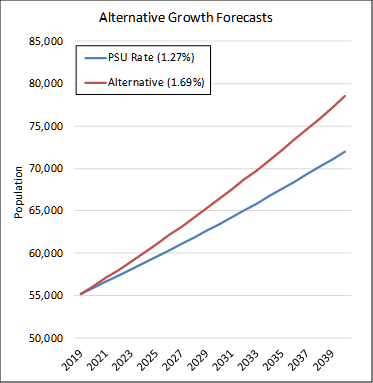
Forecasted Housing Need (2040)
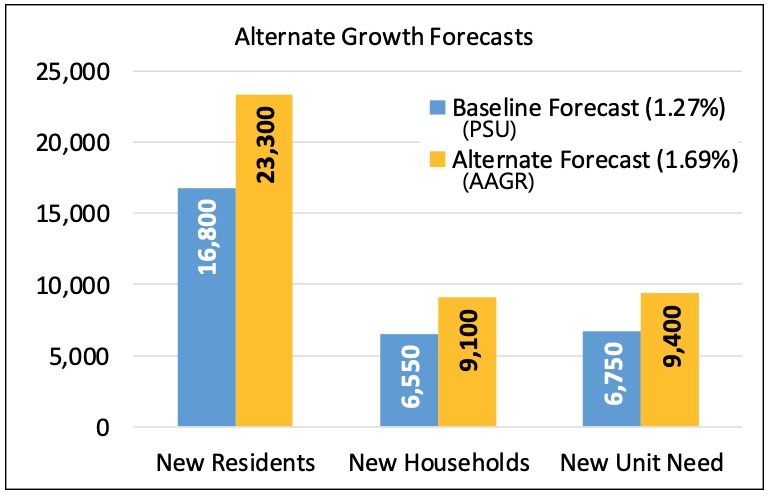
- Does not include group housing (~1,100 people)
- 5% vacancy assumed
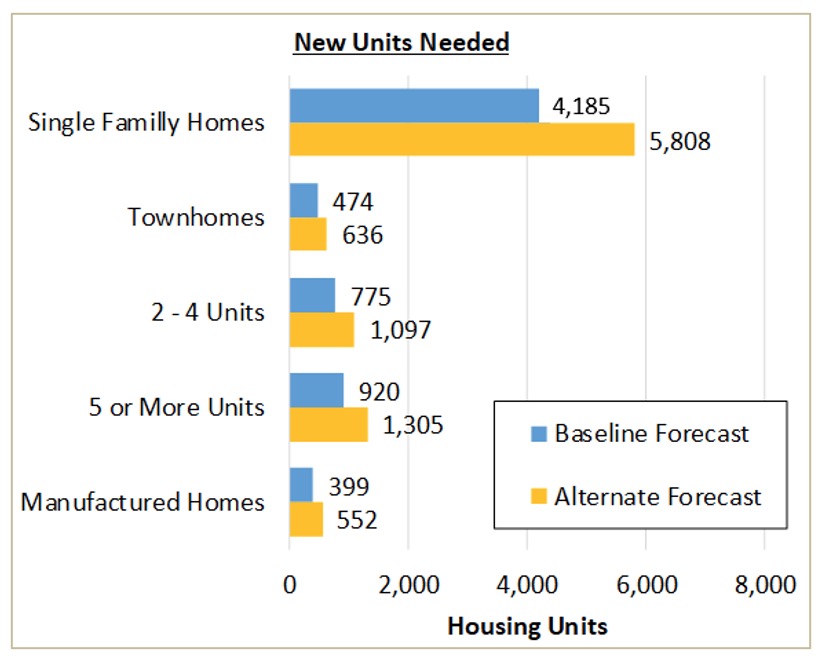
Projected Need for New Housing by Income Level

Comparison of Forecasted Land Need to 2040 with Buildable Supply in City Limits
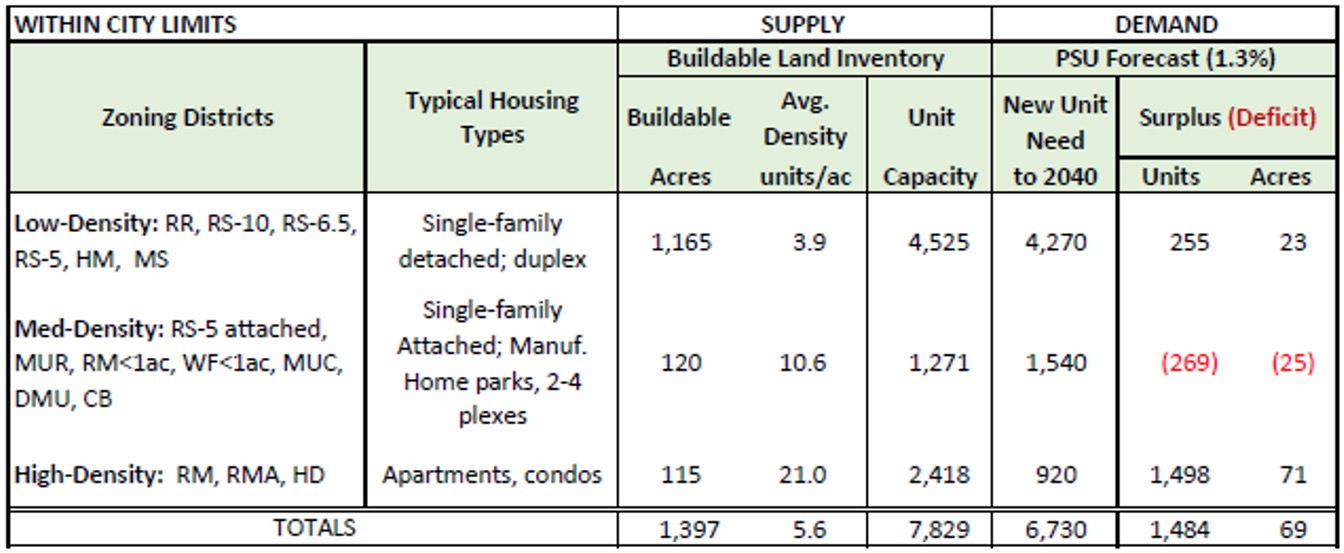
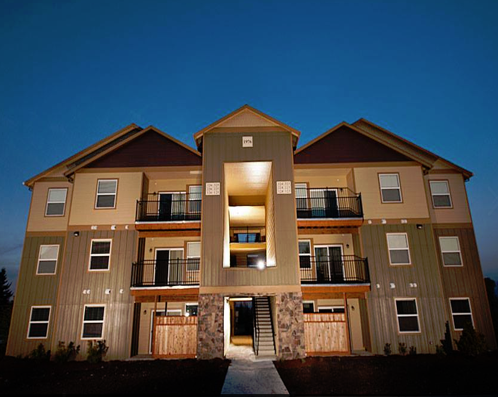
Buildable Land Supply Outside City, in UGB
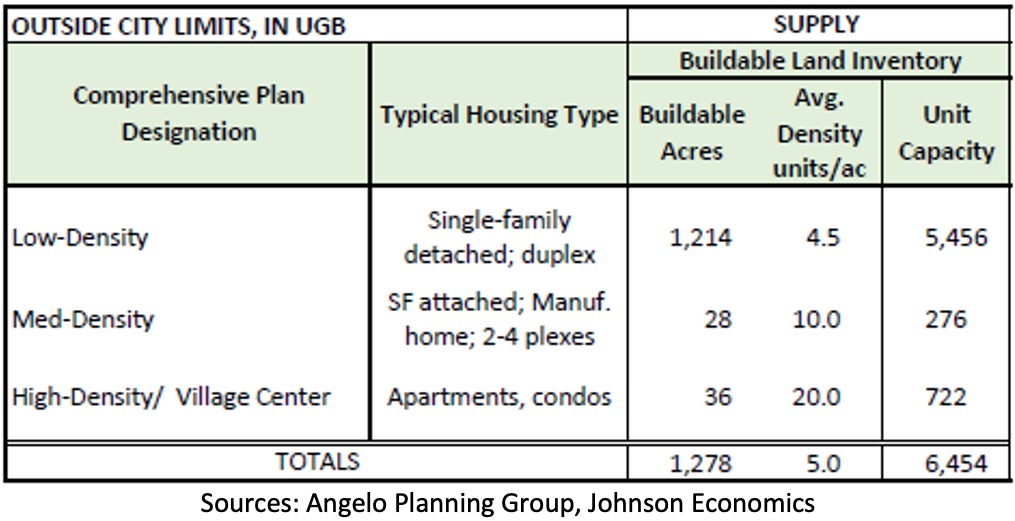
Economic Opportunities Analysis
Economic Opportunities Analysis
The Economic Opportunities Analysis evaluates economic trends, projects economic growth by industry sector, projects capacity to accommodate economic growth and compares short- and long-term demand for employment land to the existing land inventory to determine the adequacy and appropriateness of capacity over a five and twenty-year horizon.
See details below and in the Economic Opportunities Analysis.
Process

Employment Lands Inventory
Goal: Determine the amount of available land in commercial and industrially zoned and designated lands within the city and UGB.
Target Industries
Albany has significant strength and potential for growth in several key industries. Analysis of the representation of industries in the city relative to the representation in the U.S. shows Albany is strong in multiple subsectors of manufacturing. Other industry sectors with high representation in Albany are education (including the school district), some categories of retail, and warehousing. Health care is the largest segment of local employment and is forecasted to add the most jobs over the next 20 years.
Projected Employment Allocated by Building Type, 2019-2040 (PSU Forecast)
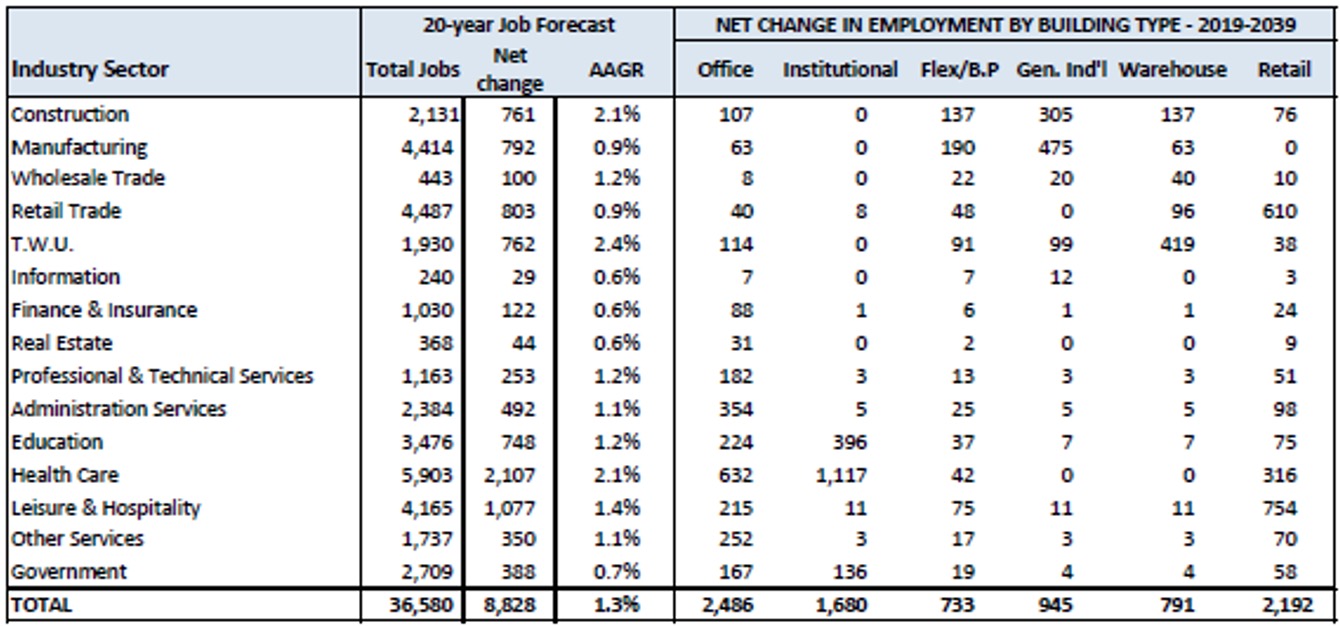
Employment Land Need and Land Supply
The EOA analysis finds that the forecasted 20-year job growth by industry will translate to a need for 562 total acres of land zoned for employment uses among roughly 400 sites. The distribution of land demand between commercial uses (Office, Institutional, Retail) and industrial uses (Industrial, Warehouse, Business Park) is fairly evenly distributed.
Estimated Number of Sites Needed by Size (Acres) and Supply, Albany Oregon
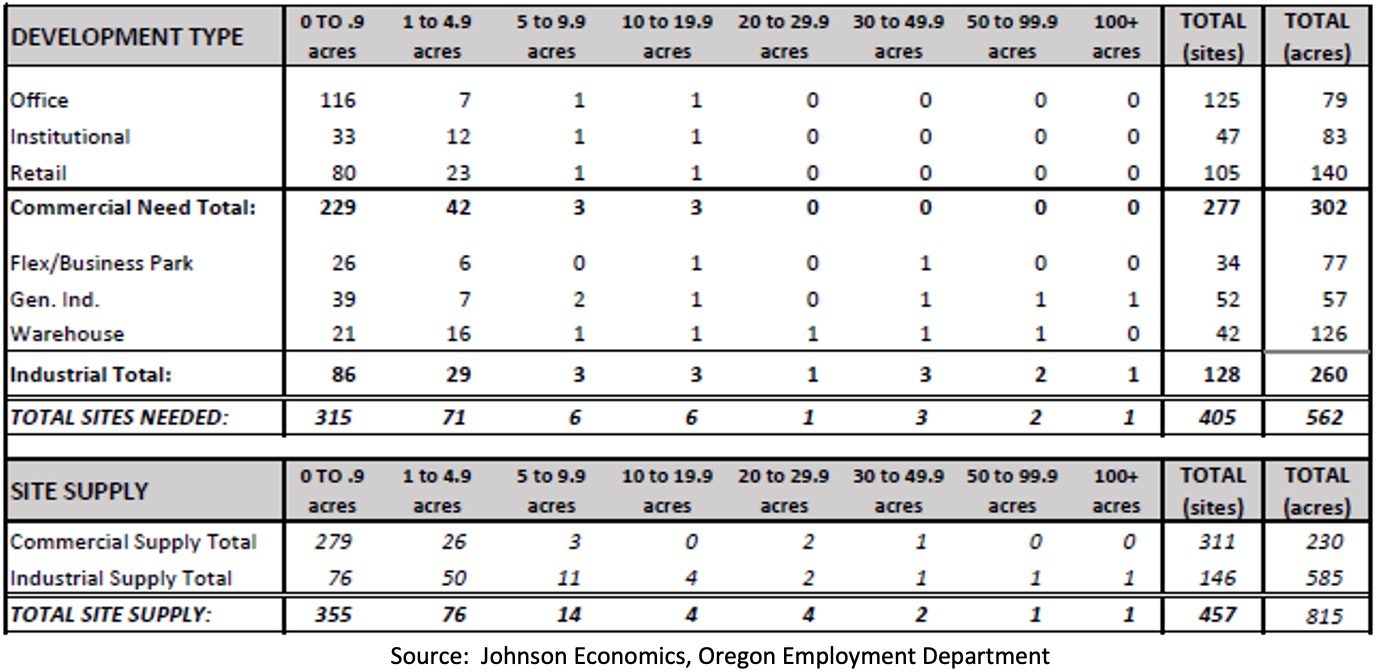
Findings
- Industrial supply exceeds demand in total acreage, but the zoning and site supply does not match the needs
- Significant share of industrial supply faces challenges to short-term or even long-term development (access, infrastructure, wetlands)
- Albany lacks a ready supply of industrial land for the smallest, and mid- and large firms (< 1 acre, and 30 to 100 acres)
- Demand for commercial sites exceeds the current supply
Provide an Adequate Supply of Employment Land & Sites
- Maintain a competitive short-term supply of employment land
- Inventory properties suitable for employment and consider rezoning/designating
- Identify opportunity sites for catalyst projects
- Prioritize serving key industrial subareas
- Evaluate options for financing infrastructure in South and East Albany industrial areas
- Encourage infill, redevelopment or reuse in central employment zones
- Continue to improve and streamline development regulations and processes
- Evaluate assisting in wetland mitigation or partnering in a wetland bank
Tell us what you think
You can also call Anne Catlin at 541-917-7560.




